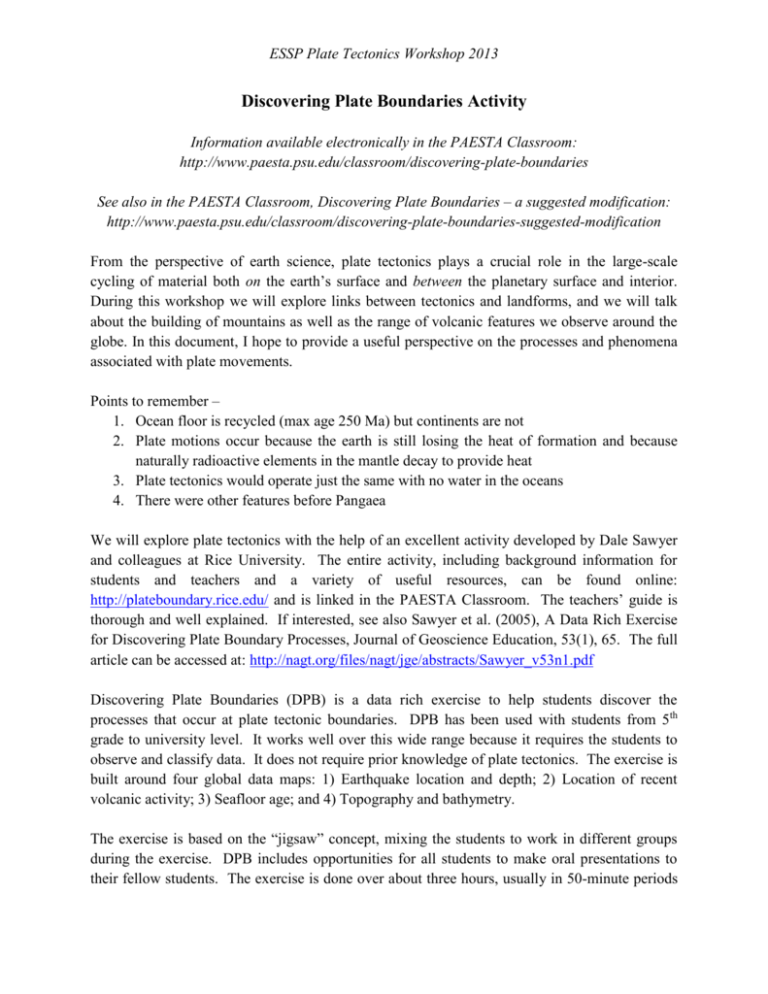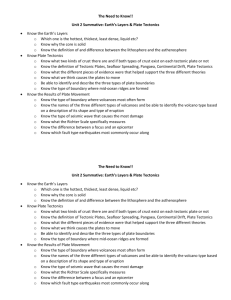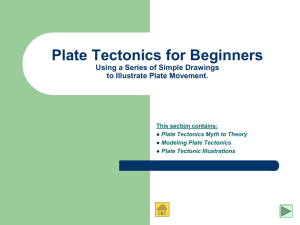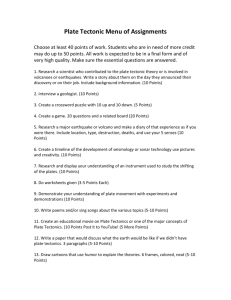Instructions - Discovering Plate Boundaries
advertisement

ESSP Plate Tectonics Workshop 2013 Discovering Plate Boundaries Activity Information available electronically in the PAESTA Classroom: http://www.paesta.psu.edu/classroom/discovering-plate-boundaries See also in the PAESTA Classroom, Discovering Plate Boundaries – a suggested modification: http://www.paesta.psu.edu/classroom/discovering-plate-boundaries-suggested-modification From the perspective of earth science, plate tectonics plays a crucial role in the large-scale cycling of material both on the earth’s surface and between the planetary surface and interior. During this workshop we will explore links between tectonics and landforms, and we will talk about the building of mountains as well as the range of volcanic features we observe around the globe. In this document, I hope to provide a useful perspective on the processes and phenomena associated with plate movements. Points to remember – 1. Ocean floor is recycled (max age 250 Ma) but continents are not 2. Plate motions occur because the earth is still losing the heat of formation and because naturally radioactive elements in the mantle decay to provide heat 3. Plate tectonics would operate just the same with no water in the oceans 4. There were other features before Pangaea We will explore plate tectonics with the help of an excellent activity developed by Dale Sawyer and colleagues at Rice University. The entire activity, including background information for students and teachers and a variety of useful resources, can be found online: http://plateboundary.rice.edu/ and is linked in the PAESTA Classroom. The teachers’ guide is thorough and well explained. If interested, see also Sawyer et al. (2005), A Data Rich Exercise for Discovering Plate Boundary Processes, Journal of Geoscience Education, 53(1), 65. The full article can be accessed at: http://nagt.org/files/nagt/jge/abstracts/Sawyer_v53n1.pdf Discovering Plate Boundaries (DPB) is a data rich exercise to help students discover the processes that occur at plate tectonic boundaries. DPB has been used with students from 5th grade to university level. It works well over this wide range because it requires the students to observe and classify data. It does not require prior knowledge of plate tectonics. The exercise is built around four global data maps: 1) Earthquake location and depth; 2) Location of recent volcanic activity; 3) Seafloor age; and 4) Topography and bathymetry. The exercise is based on the “jigsaw” concept, mixing the students to work in different groups during the exercise. DPB includes opportunities for all students to make oral presentations to their fellow students. The exercise is done over about three hours, usually in 50-minute periods ESSP Plate Tectonics Workshop 2013 on three separate days, but it can also be done in a three-hour lab period. Although the data used in DPB are state-of-the-art, the exercise does not depend on student access to computers. Unlike many others, this exercise is based on observation and classification, rather than learning computer data manipulation skills. Are you interested in reading more about the jigsaw technique? We encourage you to review SERC’s Jigsaw unit: http://serc.carleton.edu/NAGTWorkshops/teaching_methods/jigsaws/index.html. Understanding the current configuration – The emphasis of the activity is to have participants focus on some of the data from which plate tectonic theory was developed, and to hone their powers of critical observation. It is often difficult to separate what we “know” from what we “see” and most of us have some understanding of plate tectonics already. By working with a rich dataset, we can construct our knowledge from something approaching first principles. Envisioning the past – Going back in time is always difficult, particularly when we try to see beyond Pangaea. These animations can be useful. When discussing the early history of a region, we always stay focused on the tectonic implications of the individual rock units we see. How did we know there was a beach in a warm sea? We see beach sands and limestones. The rocks are our data, and from them we determine the past. Plate tectonic animations: http://www2.nature.nps.gov/geology/usgsnps/animate/pltecan.html http://www.ucmp.berkeley.edu/geology/tectonics.html http://www.pbs.org/wgbh/aso/tryit/tectonics/ ESSP Plate Tectonics Workshop 2013 ESSP Plate Tectonics Workshop 2013 ESSP Plate Tectonics Workshop 2013 ESSP Plate Tectonics Workshop 2013 ESSP Plate Tectonics Workshop 2013 ESSP Plate Tectonics Workshop 2013 Discovering Plate Boundaries Four Map Version Student Handout You have been (or will be) assigned to one of four Scientific Specialties and to one of ten Plates or Plate Groupings. The Scientific Specialties are: A. Seismology B. Volcanology C. Geography D. Geochronology The Plates or Plate Groupings are: 1. North American Plate 2. Pacific Plate 3. African Plate 4. South American Plate 5. Eurasian Plate 6. Cocos/Nazca/Caribbean Plates 7. Australian Plate 8. Antarctic Plate 9. Indian Plate 10. Arabian Plate Each Scientific Specialty group has been provided a world map showing data relevant to locating plate boundaries and understanding plate boundary processes. Each student will be provided two Plate Boundary Maps. You will mark these as described below and turn them in at the end of the exercise. There are a number of colored pencils available in the room for your use. Period 1: Assemble in your Scientific Specialty groups with your group's map Task 1. Look at your group's map and talk about what you see. What you look for will vary with data type. For the point data (volcanoes and earthquakes) you are looking for distribution patterns. For surface data (topography and seafloor age) you are looking for where the surface is high and where it is low, where it is old and where it is young. Work as a group. Let everyone talk about what they see. During this period concentrate on the whole world, not just your assigned plate (if you know what it is). Task 2 . Now focus your attention on the plate boundaries. Identify the nature of your data near the plate boundaries. Is it high or low, symmetric or asymmetric, missing or not missing, varying along the boundary or constant along the boundary, and etc. As a group, classify the plate boundaries based on your observations of your group's data. Restrict yourselves to about 4-5 boundary types. At this point, do not try to explain the data; just observe! ESSP Plate Tectonics Workshop 2013 Task 3 . Assign a colored pencil color to each boundary type in your classification scheme. Color your first Plate Boundary Map to locate your group's boundary types. If the data are asymmetric at a particular boundary type, devise a way of indicating that on your plate boundary map. Each person should mark the boundary types identified by the group on their own map. Each person should write down descriptions of the group's plate boundary classifications on the back of their map. These maps and descriptions will be turned in at the end of the exercise. Period 2: Assemble in your Plate groups Task 1. Each person should make a brief presentation to the rest of their group about their Scientific Specialty's data and classification scheme. Your group may move to each map in turn while doing this or you may have smaller maps for each group to use. Task 2. Compare the classifications of boundary type for your plate based on each type of data. Are there common extents (along the boundaries) between the different classifications? Can your plate group come up with a new classification scheme that now includes data from all four Scientific Specialties? As above, assign a color to each of your plate boundary types. If a boundary is asymmetric, be sure to devise a way to represent the asymmetry. Mark the boundaries of your plate or plate grouping using your color scheme on your second Plate Boundary Map. Also write a description of the plate boundary classes you have used. The map and description should be turned in at the end of the exercise. Period 3: Whole Class Discussion One student from each Plate Group should make a presentation to the class. They should talk about their group's plate boundary classification scheme and how they classify the boundaries of their plate. You will be given an overhead transparency of the Plate Boundary Map and some transparency markers to prepare for the presentation. The instructor will conclude the exercise by summarizing the students' observations and placing them in the context of accepted plate boundary types and plate boundary processes. To be turned in by each student after Period 3 1. Plate Boundary Map with classified using data from your assigned scientific specialty. Descriptions of the plate boundary classifications devised by your specialty group should be on the back of the map. 2. Map with your assigned plate's boundaries classified using data from all four scientific specialties. Descriptions of the plate boundary classifications devised by your plate group should be on the back of the map. ESSP Plate Tectonics Workshop 2013 Teaching About Plate Tectonics History of Plate Motions Plate Tectonics: The Rocky History of an Idea: http://www.ucmp.berkeley.edu/geology/techist.html Plate Tectonics: The Mechanism http://www.ucmp.berkeley.edu/geology/tecmech.html PALEOMAP Project - http://www.scotese.com/earth.htm Plate Tectonic Movement Visualizations http://serc.carleton.edu/NAGTWorkshops/geophysics/visualizations/PTMovements.html The Geological Story of Pennsylvania (from the Pennsylvania Geological Survey) http://www.dcnr.state.pa.us/cs/groups/public/documents/document/dcnr_014597.pdf Map available online at http://www.dcnr.state.pa.us/cs/groups/public/documents/document/dcnr_016205.pdf ESSP Plate Tectonics Workshop 2013 ESSP Plate Tectonics Workshop 2013 Google Earth for Tectonics/Volcanism/Earthquakes http://serc.carleton.edu/sp/library/google_earth/ KML/KMZ files can be downloaded for free from the SERC site (above) and the following sites: USGS Plate Boundary Map http://earthquake.usgs.gov/regional/nca/virtualtour/kml/Earths_Tectonic_Plates.kmz Smithsonian Global Volcanism Program http://www.volcano.si.edu/products.cfm?p=9 USGS Earthquake Hazards Program http://earthquake.usgs.gov/learn/kml.php http://earthquake.usgs.gov/earthquakes/feed/v1.0/kml.php








